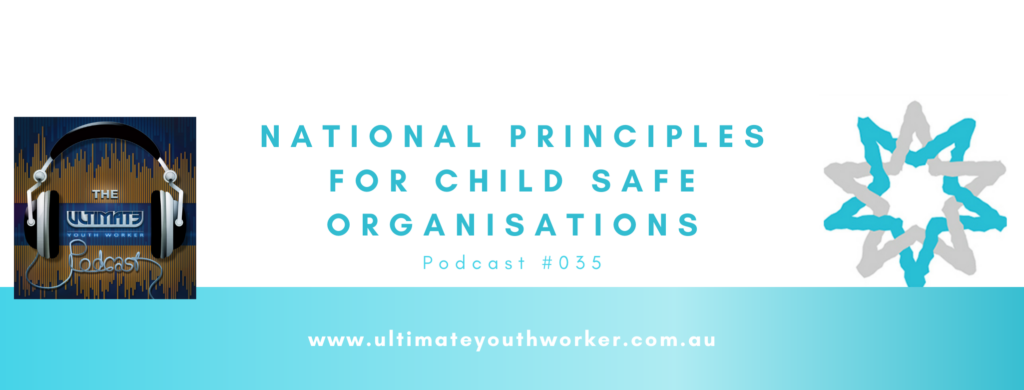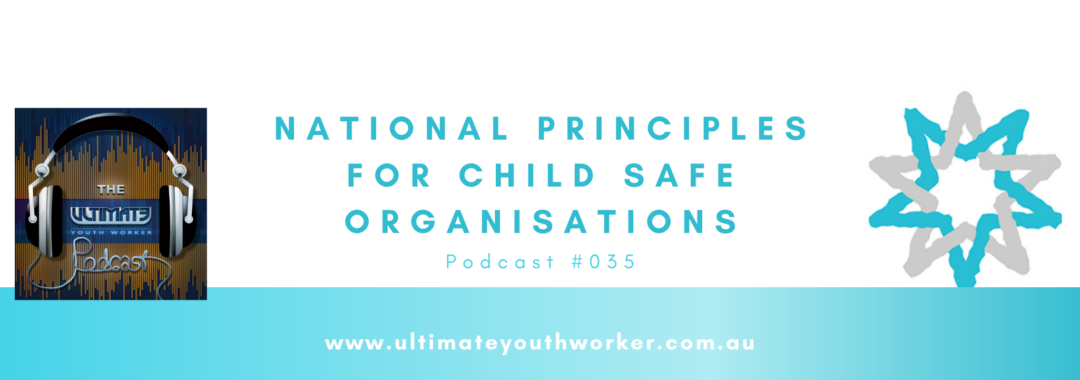
In this episode of the Ultimate Youth Worker Podcast ‘National Principles for Child Safe Organisations’ Aaron gives us an overview of the ten principles and where they came from. As youth workers our sector has always championed the rights of the child however there hasn’t been a standard that we all were required to meet. The National Principles are a guiding document for all of us in how we are to work with children and young people in Australia.
In 2017 the Australian Government asked the National Children’s Commissioner to lead the development of National Principles for Child Safe Organisations as part of the Child Safe Organisations project. The Australian Government also commissioned the Australian Human Rights Commission to develop practical tools to help organisations implement the National Principles.
The National Principles were developed under the guidance of Community Services Ministers across Commonwealth, state and territory governments under the National Framework for Protecting Australia’s Children 2009-2020. The ten National Principles respond to recommendations made by the Royal Commission into Institutional Responses to Child Sexual Abuse.
The National Principles aim to provide a consistent approach to developing organisational cultures of child safety and wellbeing throughout Australia. This will help to keep children and young people safe and mitigate future harm in organisational settings.
The National Principles for Child Safe Organisations reflect the ten child safe standards recommended by the Royal Commission, with a broader scope that covers all forms of harm to children and young people.
In June 2018, the Australian Government tabled its response to the Royal Commission’s recommendations. As one element of its response, the Australian Government established the National Office for Child Safety in July 2018. As of February 2019, the National Principles were endorsed by members of the Council of Australian Governments, including the Prime Minister and State Premiers and Territory First Ministers.
The National Principles for Child Safe Organisations
1. Child safety and wellbeing is embedded in organisational leadership, governance and culture.
This principle provides guidance on the role of organisational leadership and governance in promoting inclusive and welcoming environments for children and young people, a culture of accountability and the ways in which a child safe culture is developed and maintained.
Adoption of this principle shows that the organisation has a commitment to child safety and wellbeing through all levels of the organisation. Governance arrangements are transparent and include a child safety and wellbeing policy, practice guidance, a Code of Conduct and a risk management framework. Governance arrangements vary depending on the type, nature and size of an organisation. Organisational leadership provides an authorising environment for the sharing of information about risks to children and young people.
2. Children and young people are informed about their rights, participate in decisions affecting them and are taken seriously.
This principle describes an organisational culture that supports children and young people to understand what child safety and wellbeing means. They are informed about their rights and responsibilities in an age appropriate way. They contribute and actively participate in building an organisational culture that is safe for them.
Children and young people know about the organisation’s commitment to child safety and wellbeing and access relevant information and programs. They recognise safe environments and understand protective strategies. In such environments, children and young people feel comfortable participating in decisions and communicating their views and concerns. Ultimately, however, the responsibility for child safety and wellbeing in an organisation rests with the organisation and its workers.
Staff and volunteers value and respect children and young people’s identity and culture, are comfortable and skilled in engaging with them, understand their developmental needs and build on children and young people’s strengths and capacities.
3. Families and communities are informed and involved in promoting child safety and wellbeing.
This principle outlines the range of ways an organisation can involve families and the community in its approach to child safety and wellbeing, relevant policies and practices and the provision of accessible information. This will help inform parents and carers about safeguarding children and young people and encourage their feedback and input. They will be empowered to speak up and drive conversations regarding child safety and wellbeing and how and when they can raise issues and concerns.
Families have the primary responsibility for the upbringing of their child, and are aware of their children’s primary protective networks. There is wide variety in the structure of families, the role different family members may play in a child’s life, their backgrounds and cultures. Families and carers are best placed to advise about their children’s needs and capabilities and can inform organisations about practices and environments that are safe for their children and young people. In a safe environment, children, young people, family and community members feel that their culture and identity are respected.
4. Equity is upheld and diverse needs respected in policy and practice.
This principle examines how recognition of children and young people’s diverse circumstances enables an organisation to work in a more child centred way and empowers children and young people to participate more effectively. This builds an organisational culture that acknowledges the strengths and individual characteristics of children, and embraces all children regardless of their abilities, sex, gender, or social, economic and cultural background. A welcoming organisation is one where all children and young people feel comfortable and where services are provided in culturally safe and inclusive ways. This reduces the risk of discrimination, exclusion, bullying and abuse.
5. People working with children and young people are suitable and supported to reflect child safety and wellbeing values in practice.
This principle describes recruitment and staff development policies, including appropriate screening, that are a foundation of child safe organisations. This principle also includes induction training, understanding child safety responsibilities and cultural safety concepts, and appropriate supervision of staff and volunteers. Reporting obligations, training in record keeping and information sharing provide staff and volunteers with the relevant practice tools to better safeguard children and young people.
6. Processes for complaints and concerns are child focused.
This principle provides guidance on how human resource management policies and practices and effective complaints management processes should be accessible, responsive to and understood by children and young people, families, staff and volunteers. Complaint management processes will be linked to the Code of Conduct and provide details about where breaches of the Code have occurred. Training will help staff and volunteers to recognise and respond to neglect, grooming and other forms of harm, provide appropriate support to children and young people in these instances and meet legal requirements. This includes training to assist in responding to different types of complaints, privacy considerations, listening skills, disclosures of harm and reporting obligations.
7. Staff and volunteers are equipped with the knowledge, skills and awareness to keep children and young people safe through ongoing education and training.
This principle emphasises the importance of information, ongoing education and training for staff and volunteers. Staff and volunteers build on their knowledge and skills and evidence-based practice tools through professional seminars and memberships, supervised peer discussions, team training days and access to research and publications. This ensures staff and volunteers develop awareness and insights into their attitudes towards children and young people, and have a contemporary understanding of child development, safety and wellbeing. They will be able to identify indicators of child harm, respond effectively to children and young people and their families and support their colleagues.
Staff and volunteers are able to respond in culturally appropriate ways to children and young people who disclose or show signs that they are experiencing harm outside the organisation. Staff and volunteers are trained in the rights of children and young people in relation to record keeping, and the possible uses and audiences for records that may be created.
8. Physical and online environments promote safety and wellbeing while minimising the opportunity for children and young people to be harmed.
This principle highlights that reducing the risk of harm in physical and online environments is an important preventative mechanism. Risk management strategies clarify potential risks where adult to child or child to child interactions occur, or where the physical environment is unsafe. Technological platforms within organisations provide valuable tools in education, communication and help seeking. Risks associated with these platforms are minimised through all necessary means, including: education of children and young people, parents, staff and volunteers about expectations of online behaviour; the application of safety filters; and communication protocols.
9. Implementation of the national child safe principles is regularly reviewed and improved.
This principle emphasises that child safe organisations seek to continuously improve their delivery of child safe services and their operations. They also conduct reviews to ensure that organisational policies and procedures, including record keeping practices, are being implemented by staff and volunteers. The participation and involvement of staff, volunteers, children and young people, families and community mentors in these reviews will strengthen the organisation’s child safeguarding capacities. This includes the importance of reporting on the finding of reviews, and sharing good practice and learnings on a regular basis. Regular reviews ensure that organisations address new challenges or concerns that arise.
10. Policies and procedures document how the organisation is safe for children and young people.
This principle outlines the importance of organisations having a clearly documented child safety and wellbeing policy. This will ensure all stakeholders, including organisational staff and volunteers, children and young people and their families and carers, are aware of how the organisation is planning to meet its obligations to create an environment that is safe for children. Partner agencies or organisations funded to provide services to children and young people should demonstrate adherence to child safety and wellbeing policies and practices.
Documenting policies and procedures ensures consistent application of child safe practices across the organisation. It also enables organisations to examine, through review processes, adherence to child safety and wellbeing principles and practices.
Today’s resources
Here are links to some articles and training that have bearing on todays podcast.
- If your organisation needs some training in the National Principles we can help. Visit our Child Safety training page.
- If you need support to create policies or procedures, run reviews or involve the community in consultation, we are always available to support you! Check out our Consultation page.
- Our partners at ChildSafe Australia have a bunch of great training and support materials to help organisations become more Child Safe. Check them out.
- The Human Rights Commission National Principles website
- Podcast 022: Is your workplace Child Safe?
Thanks for Listening!
To share your thoughts:
- Share this cast with a friend or colleague.
- Leave a note in the comment section below.
- Share this show on Twitter, Facebook, or Pinterest.
To help out the show:
- Leave an honest review on iTunes. Your ratings and reviews really help the podcast and I read each one.
- Subscribe on iTunes.
